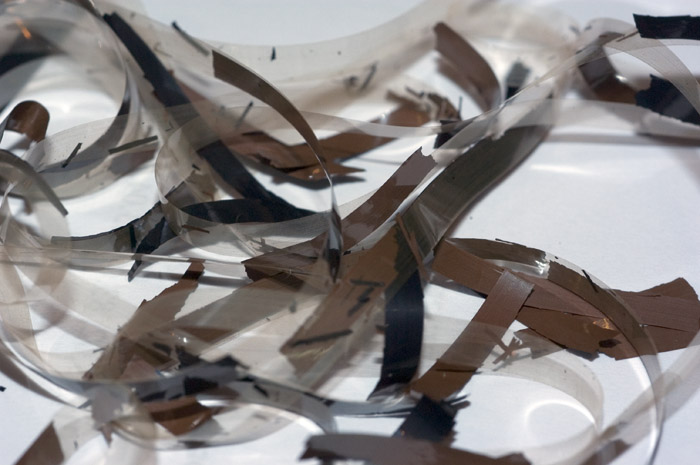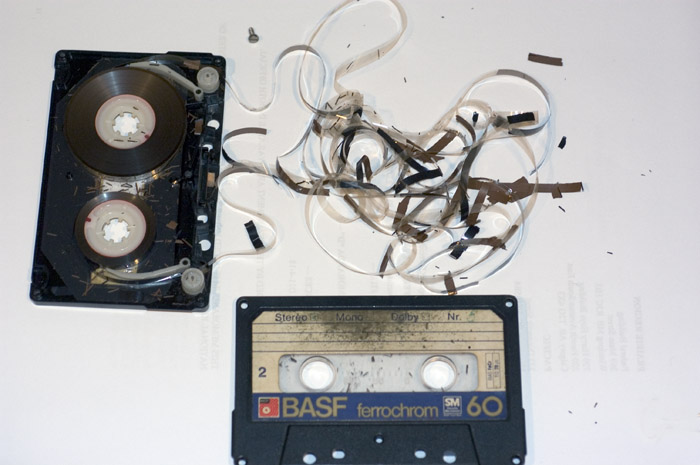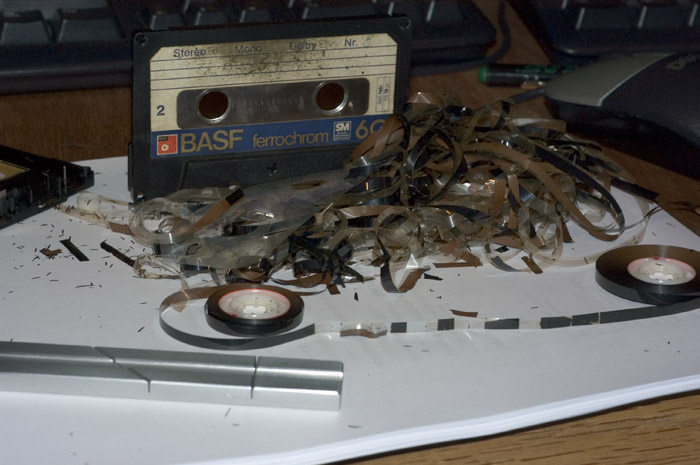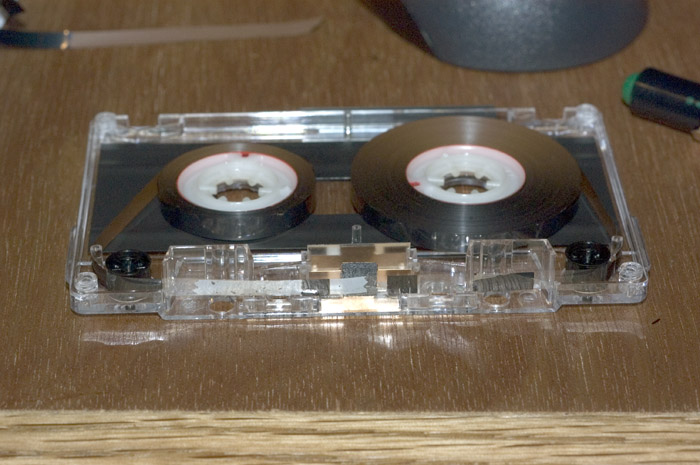A client phoned me and said a cassette he was playing started to shed in his machine and he stopped and took it out. He sent it to me and as I pulled a little bit of clear leader out of the middle of the tape, this is what I found:

Notice how the complete strips of oxide exist on their own, independent of the clear “leader” to which they previously were attached.
I immediately called the client and informed him that this portion of the tape would not be salvageable. He requested I attempt to salvage as much as possible as it contained many family voices from Europe.
I opened the cassette and it looked intact, except the tape was flaking. The flaking had only just started as he was playing, so we went and pulled off the smaller takeup hub (at the bottom in this picture) and found solid tape.

We know nothing of the storage history of this tape, other than it was sent from Europe about 2004-2005 (this is written in March 2006). The dark spot on the side 2 label has me wondering what befell this tape. Nothing looked overheated or charred inside. The specks on the paper and on the window of the side 2 shell half are pieces of flaking oxide.
We proceeded to unspool the supply side, in some instances, the backing and oxide would come off as two interleaved strands, totally unattached to each other. Of course there is no practical way to re-adhear the oxide to the backing. We kept pulling and pulling and finally found solid oxide. We spliced the two halves together.

Note the pile of tape and oxide strands behind the two spools, and the intermittant nature of the firmly attached binder right to the right of the splice. Also note the small chips of oxide all over the place.
Finally, we re-loaded the tape into a new shell as the old one was too contaiminated with shards of oxide and it was easier than cleaning the old one.

We were able to play this and interspersed with music the client didn’t want, there was a total of ten minutes of family voices that we were able to recover and then clean up in the computer. The tape had not been well recorded, either. One section required a 30 dB boost to normalize the level. Algorithmix Noise Free Pro did an admirable job of reducing the noise. Note in the above photo, the white splicing tape to the left side of the window.
Note, in the above photo, the colour of the pancakes on the hubs appears to shift. The oxide coating is probably dual layer (see notes below) and the brown side attaches to the base film while the black side faces the head. The colour shift in the photo is related to this and the angle of the camera. When handling the pancakes we didn’t see any noticeable damage as one correspondent suggested from heat.
I wonder how many other tapes will behave like this in the years to come. This was the worst I have seen to date. Others have reported similar conditions with some French Kodak tape from the 1960s, and some acetate tapes from the 1950s or 1960s.
Ben Torre emailed me some comments that help put this into perspective:
BASF FeCr and CrO2 tapes were among the best of the day, and the SK/SM housings were marvelous in the days when cassette machines had crappy mechanisms that never allowed for proper tape pack. (other than Nakamichi, of course) [You can see the SM feed arms in the second photo of the opened original cassette.] I’m guessing the one shown is early-mid 1980s vintage based on the label. These were good enough for Mobile Fidelity to use when they were selling 1:1 dupes done on JVC decks. (they used the CrO2 tapes.) They were not cheap. I have one they did of Pink Floyd’s Dark Side Of The Moon, and it sounds impressive for a cassette.
The FeCr tapes were dual-layer, so I wouldn’t be surprised if the two layers of oxide had different rates of expansion and contraction. Put them through enough heat-cool cycles, and you might see this. Only way to tell for sure is to do an accelerated aging test.
[As to the cause,] my money is on heat-cool cycles over a 20 year period. Shoe-box in the attic, or more likely a tape left near a heat source over the years. Not hot enough to melt anything, but hot enough to provide lots of dry heat for a long time. Might even have been from intense sun exposure in a window. Look at that tell-tale discoloration on the top of the label.
Don’t bet on [this being a one-off].
One other I can recall in the mid-70s. Memorex had a ferric cassette tape… I forget the designation… that after repeated plays started exhibiting dropouts. Sure enough, one look at the tape showed that the oxide was breaking off in chips from the mylar base….
I’ve also received several other emails on this post that confirm the dual-layer nature of this type of tape and also reminding me that it is a “Type 3” tape. Type 3 tapes didn’t stay long in the marketplace and were considered quite fragile at the time.
Comments:
Mikkel Breiler Posted Apr 5, 2006 8:55 PM
This cassette I bet it not newer than 1982. I believe that the FerroChrom name was derived from AGFA patents which BASF utilized after their take over of AGFA in very early 80s to make the best tape available at the time – debate we can if Chrome will stand out as the overall winner, as Chrome tape held up better due to it being a one layer tape and the fact that consumers reluctance to adopt the new TYPE III formula (probably becuase it was competing with TYPE IV) we never saw too much development at the time to get a better tape from the manufacturers who wanted to push the media. But I will vote for Chrome.
The SM mechanism was popular because it worked, most decks back in the day had awful take-up capabilities and the Security Mechanism seemed like a straight forward solution to the problem.
So when AGFA was incorporated into BASF they took a tape type that they hadn\’t developed themselves and added their – if I recall only type of mechanism that worked towards an even spooling – SM invention. And I believe were it not for all the diseases the TYPE III tape-infant had to endure the type might have survived longer – but personally either TYPE IV or TYPE III would have eventually won most ground.
I have some one or two AGFA FerroChrom cassettes and I believe two BASF FerroChrom cassettes. And also a Sony 7′\’ reel of FrCr-7-550-BL tape, and I have them only for reference because I happen to have decks which allow for selecting such. Neither tapes in my collection display the problem seen here.
And I am surprised that the BASF tape had problems like the one pictured above. But as the patents were developed otuside of their lab this poor tape from BASF may be the results of poor management at lower levels where AGFA engineers and other knowledgable people did not receive enough credit for their pioneering efforts and were not allowed to continue to make even better versions of the TYPE III tape. Or hindered in doing so.Now for the observed discolouring. I have seen this one several BASF cassettes of the early 80s, with the SM invention. And I must conclude that it is simply poor glue for the labels. This is not something only found with BASF tapes of bygone times, but something several brands have ocasionally exhibited. Though in my collection TDK, Maxell and Sony have never had the issue. I have more pre-recorded cassettes with this problem (and the glue drying out so the labels is loose/missing) than I have BASF or AGFA tapes with poor glue. But it may happen.
Storage is the key, and apparantly the brave little tape you got never stood a chance.It does strike me as odd when BASF – knowing that the brand covers a lot of factories that produce this or that chemical and – would have enough ties with other companies to come up with better glue for labels than what we see was apparently the case. maybe this is just another anomaly we can chalk up to ‘management success\’.
But not every company can draw a winner when several years on, one engineers idea that looked very effective, cost saving, and or which the marketing department found would be useful as a buzzword, became a wrong decision. Hindsight is always 20-20.
So the FerroChrom tape had been out for a few years in its heyday, but when this baby hit the street either BASF was asleep at the factory or just did not bother too much with a slow seller which showed no improvement in the market, and poor storage just got the better of it.
Sincerely
Mikkel Breiler
Tony Amato Posted Mar 23, 2006 7:04 PM
These FeCr dual layer tapes were one of three brand formulations available between 1980 and 1986. Sony, Scotch and BASF were the 3 major players for Type III formulations. Dual layer configuration ~ top coat (layer) of chromimum dioxide over a base coast (layer) of ferric oxide. Great combination when you think of it ~ yet prone to drop outs when to subjected to climatic changes that can occur in an automobile or just general improper storage. Many considered it a low cost alternative to the then expensive Metal Type IV formulations that were emerging.
I still have a cache of Sony FeCr tapes recorded in the early 80\’s ~ recordings of the Mobile Fidelity Beatles Collection vinyl. They have mostly survived due to careful storage, but some are now suffering from signal loss and a couple have begun to shed in similar fashion as the one depicted above.
Anyone having critically archived voice or music on tapes of this age, let alone tapes of this formulation, should seriously consider digital transfer before Oxidation and Age catch up and steal the recordings…
Tony
More from Tony on Apr 17, 2006 11:51 AM
With regard to the top of label, centered discoloration ~ It strikes me most obviously as natural oil/soil remnants from handling by a greasy/dirty set of fingers (more than likely build up over time) and then, subsequent aging, oxidation and environmental attack to an already weakened label surface. I\’ve seen many a tape label look this way by way of friends who have massive tape collections and not a single sense of how to handle such a delicate product…
B77 Experience Posted Jun 4, 2006 10:29 AM
I recently bought a lot of still sealed BASF CSII from about the same time (a slightly newer model, but still a SM edition, with the large window).
The tape is perfect (typical BASF Chrome, no dropouts, good high frequencies, not too tolerant to hot levels), but the untouched labels exhibit dark spots all over (although they are distributed in a uniform area).
Strange enough, Side 2 is worse than Side 1 on all of the 4 tapes I bought. More glue, perhaps?
So, either a problem with glue or ink.